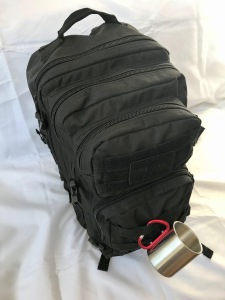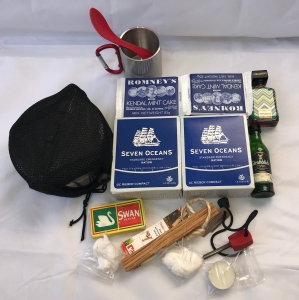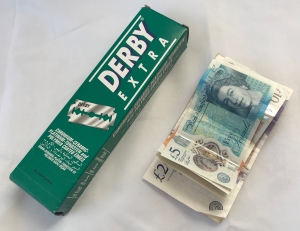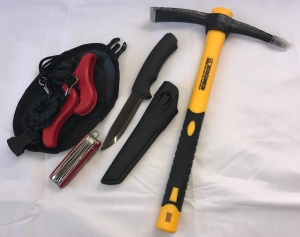Why keep a bug out bag?
The phone has rung. The emergency message pinged on your mobile. The radio comes alive and the rolling TV news has only one story. It’s happened, come true, the end of civilisation. Natural disaster. World War III. Alien invasion. A fast spreading equine influenza jumping the species boundary, or just a plain old zombie apocalypse. If you’re lucky it’ll be only one. Either way, you’ve got to evacuate.
What’s this post all about?
Since I put together my first bug out bag, detailed in the post where I blagged the first paragraph, which was put together with what I already had lying around the house, I’ve conducted a series of tests and undertaken research to find out if I can make improvements which increase my survivability should the need for the bag arise! Following below are the details of the updated bag and its contents, along with links to the articles showing the research.
I’ve split the contents into different sections to help you follow. Although many items could easily be included in multiple sections, further underlying the quality of their inclusion, I have only included them in the first category in which they appear.
The Bag
The original bag was a 25 litre day sack plucked from the bottom of my wardrobe. It’s seen many a camping trip and canoe down they River Wye, but it was smaller than I needed and was awkward to get to all the contents without spilling everything across the floor. I have now upgraded to a 36 litre Military style MOLLE rucksack in black.

Wikipedia tells me MOLLE (pronounced Molly) stands for MOdular Lightweight Load-carrying Equipment. It is a system used for military equipment which uses rows of heavy-duty nylon stitched onto the vest/pack to allow for attachment of various MOLLE-compatible pouches and accessories. These are called PALS (Pouch Attachment Ladder System).
It has two main compartments which fully unzip, allowing access to the bottom of the bag without having to take all of the contents out. In addition it has two outer pockets for those smaller items you might want quick access to.
Waterproof Cover – It didn’t come with a waterproof cover, so a separate cover has been added to the kit list.
Cooking & Eating
- Camping Stove – It’s out with the Trangia and in with the Wolfyok Stove and MSR cooking pot giving me the ability to cook or boil water either with solid fuel or with scavenged wood and twigs. The burner packs away into the MSR cooking pot along with a small pack of alcohol fuel. Click here to view the post where I chose this over the Trangia.
- Fire Steel – Lightweight and able to use in all weathers for lighting the stove and making a traditional fire too.
- Matches – A second ignition source just in case!
- Two Baggies of Cotton Wool – Recently added as fast burning tinder when I found out wood shaving just wouldn’t do the job alone. For more about lighting a fire with this kit click here.
- Tea Light. For lighting wet wood and to dry the tinder out. The candle is also a great alternative to the alcohol tabs for getting the wood to burn. This was from a suggestion from a fellow blogger.
- Tin Mug – Clicks to the outside of the bag and it’s very light. Lots more uses than just for drinking.
- Food – Emergency Rations – 18 bars – 1kg – In their simplest form they are high calorie biscuits which in emergency situations can sustain one person for 72 hours. They have a five year shelf life, but will still keep the calories after. At half a kilo a box, they’re heavy, but worth the weight.
- Kendal Mint Cake 85g x 8 – High calorie sugary energy. Click here to see how I chose the food.
- Spork – A spoon, a fork and a knife too. Doesn’t that mean they need to change the name? Either way it’s coming with me.
- Alcohol – A treat and high in calories. Help keep the cold nights at bay and the moral too!
Light Sources
You’re going to want to see in the dark.
- Low light torch – With four colours of light to select from, it’s great for keeping yourself concealed and not damaging your sensitive night vision when you use it. Who knows what’s going to be hunting you down at night?
- Wind up Torch – Works without batteries. Enough said?
- Head lamp – While the batteries last it’s a great task light. Use it for putting up the tent, then put it away for next time.
- Glow sticks – An emergency alternative to the torch, won’t give off enough light to work to, but will show you position, if you want to be seen of course!
Water & Hydration
NHS guidelines are for 1.2 litres per day to keep dehydration at bay. You’ll need more if you’re hiking or running all day.
- Bottles of Water – Bring as much as you can carry, but you will need a constant supply.
- Filtration Straw – If the water is contaminated in a nuclear fallout, there’s not a great deal sterilisation and filtering can do, but in every other circumstance a Filtration Straw will let you filter up to 2,000 litres / 530 gallons direct from the source. It’s a no brainer.
- Chlorination Tables – Light and easy to use as an alternative to the straw.
- The cooker could be included here. Boiling collected water is one of the best ways to make sure you’re not going to hurt yourself with what you’re drinking.
- In this post I discuss how you can make water collected in the wilderness safe to drink.
Sleeping and Shelter
- Sleeping Bag – It’s small, lightweight and three season. Should deal with most of what the English weather can throw at me as long as I have shelter.
- Tent – Again, small and portable, weighing just over 2kg / 4.4lbs it gives options for where I can eventually go.
- Camping Mattress – It may seem trivial, but not when you’re lying on the cold hard ground trying to sleep with one eye open.
Survival
- Emergency Kit – Contains 21 different items to help you survive, including a fishing line and hook, tinder and a knife, all wrapped in woven paracord.
- Paracords – With boundless uses in survival situations and lightweight, it’s a must.
- Compass – Even without a proper map you can travel in a vague direction and keep yourself on a course. Overlooked first time around, but invaluable, especially if you already have one.
- Sewing Kit
- Survival Blankets
Bartering & Payments
- Cash
- Razor Blades – Perfect for trading when the cash no longer has any value. Click here for more ideas of what to bring along.
First Aid Kit
I went over this in a recent post, click here to see how you can use the kit.
- Adhesive bandages of various sizes
- Blister plasters
- Butterfly bandages – For closing wounds
- Gauze pads of various sizes or gauze roll
- Antiseptic creams and ointments
- Sterile wipes and rinse solutions
- Pain and anti-inflammatory medicine
- Tweezers, scissors and safety pins
- Anti-diarrhoea medicine
- Antihistamine for allergic reactions
- Eye drops / wash
- Tick removal tool
- Cling film
Health
Items for the promotion of health.
- Hand Sanitiser – It won’t last long, but used sparingly it will help stave off stomach bugs, plus it’s flammable.
- Universal Wipes – Keeps thing clean. Keep yourself safe.
- Toothbrush and toothpaste
- Vitamins
- Fold Up Spade – It’s heavy, but has so many uses, including covering up your waste.
Tools
- Hand Saw
- Micro Pick – Not just a tool for digging stuff up.
- Proper Knife – I’ve ditched the folding fruit knife for something more substantial. Great for carving wood and helping to make a shelter, plus more comforting when I don’t know what I’ll face while I’m out there and the world has gone to the dogs.
- Pen Knife – So many tools in one handy package. Just don’t lose it or you’ll lose so many tools!
- Nails – I’ve ditched the hammer, but I’m keeping the nails, giving me options for building shelter.
Other Stuff
- Wooly hats and gloves
- Wind up radio – You can get them with solar power too, plus USB charge to give you that first kick start, plus they come with powerful emergency lights. Keep on top of the latest details of the emergency.
- Passport – You never know. In an emergency I’m sure the rules would be relaxed, but when it all settles down, if it ever does, then it would make resettling so much easier, if there’s anything left. Keep positive. Probably the most important lesson.
- Clothes – Quick dry trousers, essential in any weather. Layers of technical clothes, the best way to stay warm. Hiking socks are a no brainer for comfort.
- Spare Glasses
- Microfibre Towel – Super lightweight
- Waterproof Notepad and Pencil
- Gaffer Tape – With thousands of uses in a survival situation, it could fit in any of the above categories.
- Toilet Roll – A last minute edit as I’d left it off, but when I have to go I’ll be so thankful for the comment!
What’s Next?
So the kit’s good. I know it is, but at 18.2 kg / 40 lbs I think I can do better. In the future I’m going to be looking at the big items, the sleeping bag, the mattress and the tent to see if I can shave off the weight. With less weight I can either stuff more food in if I get a spare moment when the emergency strikes, or it means I can be more mobile, run faster, go for longer if I need to. Keep an eye out for future posts by either following me through WordPress, Twitter or Facebook.
Thanks for taking the time to read and I’d love to hear your comments and any details of what’s in your bag on any of my channels!
In the meantime why don’t you have a look at how I’m getting along in my publishing journey.
In the End
What if you woke to find the electricity off, the internet down and the streets deserted? What if you were forced to run for your life, no longer top of the food chain? What if the government had no interest in keeping you alive, but you’d found a reason to struggle on, a new meaning to this life, those around every corner intent on hunting you down?
Could you survive the end of civilisation?
Meet Logan. That’s me. The first to believe the world had changed forever. The first to urge our friends to run. The first to kill, but not the first victim. I was the first to see for myself as nature bent before my eyes. With death surrounding, getting ever closer, they looked to me for answers.


How about a roll of bathroom tissue? Id make room for one 1000 sheet 2 ply roll to use in the wild until
I can find an adequate substitute, whatever that would be. When you gotta, go, you gotta go.
LikeLiked by 1 person
Yes you’re right. Leaves will lose their novelty very quickly!
LikeLiked by 1 person
You need a wee fishing kit in there too… the survival ones are small and compact! 😉
Penile flares… in case the rescue chopper can’t see you! 🙂
Mostly though … you need the Will to Survive!! 😀
LikeLiked by 1 person
Agree on all points. Thanks for commenting. There’s a line and hook in the survival kit already, are you suggesting something more substantial? You’re right about the will to survive!
LikeLike
Good points, you never know if or when you’ll have to evacuate. Best to be prepared and never have to use it than the alternative.
LikeLiked by 1 person
GJ,
You have done your homework. Excellent job. Your attention to detail and research challenges me in my work, as a writer and a camper.
I pray your book does great and you keep doing this book marketing, adversting right. I have to lay aside my sci-fi book for a year while completing my Masters. So, will be taking notes as as always pass your work on to my hiker friends and felllow writers.
Many safe and smart adventures,
Gary
LikeLiked by 1 person
Thanks Gary
LikeLiked by 1 person
Instead of wind-up flashlights, look into solar-powered lights such as those by Hybridlight. They are, no pun intended, brilliant – and I don’t leave home without a Hybridlight Journey 160 and a PUC. They have USB ports you can charge devices with too. They’ve saved my bacon many a time when the power goes out here.
Good on you for learning to use a firesteel. More people need to learn how to use this fantastic firestarting tool!
LikeLiked by 1 person
Thanks for the feedback. Will definitely take a look at your recommendations
LikeLike
Ah, I wish I would’ve noticed this sooner! Yeesh, how old was the post I first commented on….?
I’m not sure how big my backpack is, but it feels almost oversized to me. I suppose I’ll grow into it. Olive green, a few random bleach stains, good old-fashioned waxed cotton canvas. More waterproof than you’d expect. I wish I could carry more water, but I’m smaller than most 10 year olds, so I gotta stick with a liter in a stainless steel bottle. Plus a little extra in a hip flask, and my distiller/filter setup. Like 60% of my gear is either handmade or heaviliy modified.
For my size, I carry a lot of weight. Quite a bit of food and medicine, all in reusable metal tins, with extra for my niece and nephew. Adults should carry no more than 25% of their body weight on their back*, while children, the elderly, and the disabled should carry no more than 10%. I weigh about 100 pounds**, so my backpack should be under 25 lbs.
* Carrying some gear on the hips and thighs helps to even out the load, if you keep the weight balanced enough. Rather not impede your running or climbing. I carry my medical kit on my left thigh, and various other gear on my right thigh.
** Sorry if I bounce between different units of measurement. My mind is stuck in that awkward place between liters, ounces, and cups.
LikeLiked by 1 person